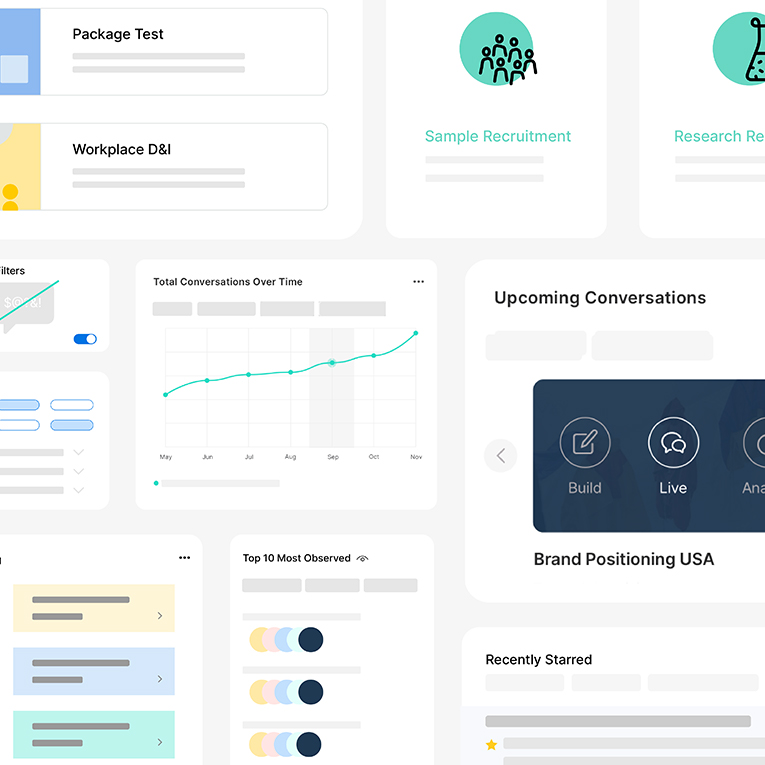.webp)
Trends
How to Calculate Your Sample Size Using a Sample Size Formula

.png)

.png)
Read More

.png)
.png)
.png)
Maria Noesi
November 25, 2021
.webp)
.webp)
.webp)
.webp)
.webp)
Product-Market Fit For Corporate Brands
Product-market fit is not just for startups. Corporate brands should constantly evaluate customer need and fulfillment gaps, regardless of tenure on the market.

There comes a time in the growth of a company where it sits at the crest of success. Reaching the cruising altitude above your competitors, rolling out products into the market as fast as your clients are asking for them, bulldozing sales goals - these types of companies are on cruise control. This phenomenon hits its stride at the intersection of customer and product.
This peak is known as product-market fit.
Product-market fit is one of the most difficult business goals to achieve, especially for long-established companies hit by more agile startup competition, and limits corporate brands from achieving their full potential. How is product-market fit achieved, and what steps are critical for agile corporations - not just startups - to adjust for it?
Challenges Of Establishing Product-Market Fit
If you look at a broad spectrum of companies, there are inevitably two ends of success: companies fail because markets can’t sustain enough demand for growth, or they find their niche in a sustainable market.
Additionally, company success is threatened when they can’t keep up with the change in market pace. Researching and developing products should be the default state for any product team. If a product goes too long without adapting toward customer needs, it could fall out of competition with other products.
Using a Product Innovation or Concept Testing Platform
A common example of this obstacle is, say, a personal care company with diverse grooming products. The products sell well in the market and meet the needs of the company’s customer profile. However, sales could be even better, and that company is interested in quick insights from customers on alternative business models, like the subscription-based purchasing or direct-to-consumer purchasing options commonly offered by startups.

In this scenario, a company might use a product innovation or concept testing platform to directly confront customers at scale.
After using a product innovation or concept testing platform, you might discover new customer problems. How can your company establish a solution? How can you optimize your product to be a solution for this type of customer specifically?
Steps Toward Establishing Product-Market Fit
1. Reevaluate Your Customer Personas
Defining characteristics for your target customer is made up of several segments. Researchers typically start at the broadest, basic demographic segments, which are things like age, race and income. Then, as the research process continues, researchers can tailor their larger segments into smaller, more in-depth segments. These can include buyer habits and personality-based traits.
Each segment is intended to build another trait into your target persona, the profile of customers buying your product. Giving your product team an idea of who they are designing the product for will make critical differences in the way your product is executed.
As you are compiling a following of customers, use your customer base to build off of itself. Each new demographic that your product is appealing to offers a new way to market your product or build your features outward. Customer feedback is a key asset in this research, but it can be tricky to find.
2. Discover Unmet Customer Needs
There’s a difference between a product that fits a need, a product that could fit a need, and a product that fits a need yet served. Focus on the underserved needs of your market. What aspect of the other products in play (i.e., your competitors) don’t satisfy a solution for your customer entirety?
Use the gaps in the market to draw from these necessities and figure out how to design a product that checks those boxes between usefulness and need.

Another aspect of product-market fit is positioning yourself as a problem-solver to your customers. The goal of this strategy is to encourage customer promotion of your product. If your product is adaptable to several sectors of an industry, you’ll be able to develop a higher level of customer engagement.
3. Forecast Potential Market Share
All markets are not created equal. Chasing a profitable market lands you in a place of dense competition. In any market, companies position their products facing outward to their audience.
Marc Andreessen, billionaire investor and founder of the Silicon Valley venture capital firm Andreessen Horowitz, first addressed the term “product-market fit” in his post “The Only Thing That Matters.” Andreessen points out that in an ideal relationship between a product and the market it lives in, the demand will pull innovation out of the company in the form of new and improved products.
Your product should evolve with customers. Pay attention to the changing needs of your customer base, the development of competing products and companies, and the change in potential the market can offer. It’s much more of a give-and-take relationship than a single-direction transaction.
4. Create An Adaptable Product
If your customers are giving feedback to improve your product, be sure that your team is ready to use that feedback in sculpting your product and marketing to more effectively meet the demand.

Many of the biggest companies on the market were driven by changes in customer need. Companies like Google and Facebook have taken their success from developing a sustainable market. However, this market took time to grow and evolve the profiles for people who are buying their product or service.
The market wasn’t built in a day. For instance, a small-scale online bookstore grew and shifted through different markets to eventually become Earth’s biggest marketplace, Amazon. Thinking like a startup means companies are quick to adapt and react to changing customer needs.
You may be able to access customer feedback through a research process, but once you get there, how do you move through the research process with the new information you just collected? Learn more about managing customer feedback in a few simple steps to bring the most efficient information back to your team to work with.
5. Build Sustainability Into Your Product
Achieving product-market fit won’t happen overnight, and it may come and go with the market. Your product, then, should never be stagnant. If you’re developing a new product, understanding the role that this achievement plays in the market will help attract and retain customers.
Much of this product-market fit evaluation and development comes from leadership, the strength of which is often the number one concern for investors before writing a check. Are the decision-makers passionate about growing the company? Are they aware of the risks the company faces in the market? If not, an investor will move on.
Summing Up Product-Market Fit
By understanding the level of achievement that your company is working toward, you can get a better idea of the way your company will be able to execute it. Product-market fit is as much of an art as it is a science. It requires adaptability and an effort to always be improving.
Once the product-market fit is reached, it takes a high degree of tenacity and effort to sustain. Be sure that your product is in a constant state of motion, and give your customers a great product that thrives as a force in the market.
{{cta('954cb96c-07b6-4935-9aaf-eed426dbde13','justifycenter')}}
More

Remesh Evolution: AI-Powered Insights Platform Unveils Major Updates to Satisfy Market Demand for High-Quality, Human-Centric Research

.png)

.png)
Read More

.png)
.png)
.png)

.png)

.png)
Learn More

.png)
.png)
.png)


Stay up-to date.
Stay ahead of the curve. Get it all. Or get what suits you. Our 101 material is great if you’re used to working with an agency. Are you a seasoned pro? Sign up to receive just our advanced materials.



